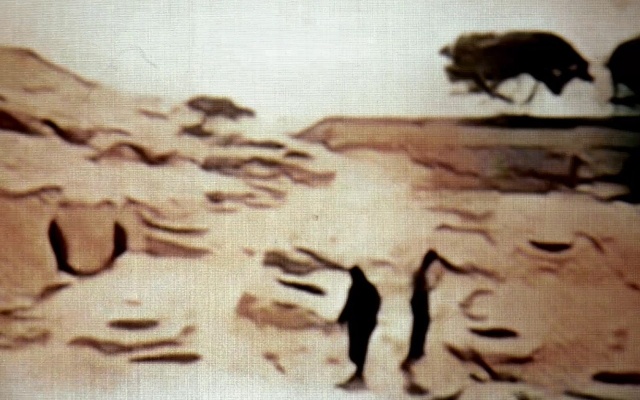Dustopedia (Ghobar-Nameh) is an ongoing research and archive curatorial project carried out by New Media Society in response to an invitation by Anna Ptak, a curator based in Warsaw, and it was meant to be exhibited in Warsaw in 2015 along with the project DUST/KURZ/غبار. It is an encyclopedia around the theme of dust, bringing together its appearance and reappearances through various media such as text, moving images, and found materials.
Due to some problems and complications, Dustopedia wasn’t released during the exhibition, and the team decided to continue the project on their own and present it when another opportunity presented itself in Iran. Meanwhile the archive was growing in many directions, and finally, in early 2018, the New Media Society decided to dedicate its project space to Dustopedia for two months starting in April. The project consists of an ever-changing wall installation, a study room, and a screening area for talks and presentations.
The subjects which are being researched vary from the representation of dust in documentary and feature films, works on paper, collecting news pieces, and paper clippings regarding the Haze Micro-Dust Crisis in southern Iran and environmental issues caused by water shortage and drought, to side effects of the wars in the region, as well as philosophical and metaphorical readings of dust in literature, poetry, and film. The project invites the viewer to actively participate in the process by engaging in the conversation within various related disciplines and helping the archive by submitting materials and expanding the entries of the Dustopedia. The result is imagined in the format of an internet website and possible publication.
In association with the concept of dust this project tries to explore fundamental questions such as: what do we know about dust? Is it only floating/sitting matter or are there other layers/readings to this phenomenon? Are we cursed to dust up constantly, or just fribble the remaining days away in comfort? What if we accept it as a condition/space which can initiate change? How would the relationship between the center and the periphery, be re-drawn in accordance with the dust density and/or its traces? How does it make reference to death, decay, and dissolving, giving us a hint by the remanence of a once-existing object? How does its ever-changing composition bring up coercion and exigency?
Despite its popular definition, the word “dust” can be taken as a signifier to separate the periphery from the center – as the place where power is concentrated and should be kept clear, pure, and visible at any price; but the periphery, on the contrary, is a place/space for dust. It is always expelled/discarded to some remote places out of sight, dust will not attract any attention until it reaches the center. Maybe that’s why outcasts and the forgotten are always associated with dust. A center is a place worthy of sweeping, hence dust and rubble are the largest export to the marginal territories; nobody bothers to sweep the periphery.
Dust is always on the news when it is too late – when it is up in the air and everywhere is filled with it. Once the dust is back on the ground, the oblivion starts to roam. Somehow “the settled dust” completes the process of opacity and hypocrisy, it devours the structures of power or transmutes them within itself. When the horizon is clear again, things seem normal and explainable: hide the witness and claim that the damage never happened, or that it was worth it in order to create a better world. (Look at 9/11 a terrorist attack transmitted worldwide, which cast a persistent fog over the North/South and changed international relations forever. There is no need to mention the first and second Persian Gulf Wars and their disastrous ecological aftermaths and the void they created that lead the Middle East into its current state of horror, the rise of ISIS and ongoing Syrian war).
Collected dust, on the other hand, refers to the archive, the analog, and sometimes the history itself and all possible nostalgias one can attach to them: the term “collecting dust” to describe a deserted subject, place or matter, is an example for such associations. Looking at the representation of the near and Middle East in Hollywood and Western media, these associations are often beyond the actual geography and walk their own path: their gaze is commonly mixed with fiction in addition to an orientalist view, to extinguish a burning wish for the exotic. These often complicate the understanding of the other, while acting as a cover like a veil or a filter to distort and obscure the view, pushing it to an unclear mass of particles where one cannot guess what the actual objects were that are buried under dust.
Dustopedia is an encyclopedia with the capability for change, and the possibility of adding new entries; archival/live entries of text, image, and film, toward various domains: from scientific and ecological perspectives to rather abstract philosophical matters surrounding dust. Various portions of it get completed in the course of time and in the process of collective search and investigation. To separate these interconnecting matters, chapters, and entries – designated to be filled with found objects/footage/text fragments – these entries, themselves, will also be capable of expansion.
For our contribution to Obieg we have selected two chapters to be included in this essay: Moving Dust a video program curated by Amirali Ghasemi from the Parking Video Library and Dust in Mysticism by Nebras Hoveizavi.
BIO
New Media Society is a project space, archive and Library dedicated to New Media Arts. NMS acts as a hub and mediator for several emerging project spaces across the country. They archive and facilitate projects related to new media arts by organizing talks, workshops or events such as presentation, symposiums, and exhibitions. Publishing, knowledge production, archiving and preservation as well as public outreach are key tasks to provide a most needed platform for ever growing scene of new media in Iran.
* Coverphoto: Nebras Hoveizavi, 2017.



